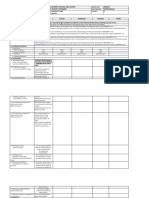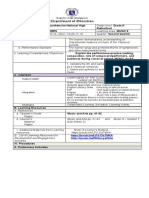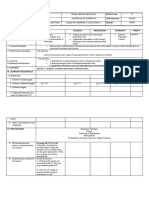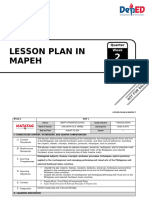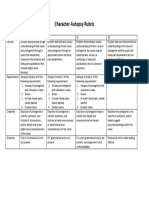11 MU9MRB Ib F 6
11 MU9MRB Ib F 6
Uploaded by
Ahra SoCopyright:
Available Formats
11 MU9MRB Ib F 6
11 MU9MRB Ib F 6
Uploaded by
Ahra SoOriginal Title
Copyright
Available Formats
Share this document
Did you find this document useful?
Is this content inappropriate?
Copyright:
Available Formats
11 MU9MRB Ib F 6
11 MU9MRB Ib F 6
Uploaded by
Ahra SoCopyright:
Available Formats
Republic of the Philippines
Department of Education
Region VII, Central Visayas
Sudlon, Lahug ,Cebu City
Instructional Plan
Duration: 60
DLP No. : 11 Learning Area: MUSIC Grade Level: 9 Quarter: 1
minutes
Explores other arts and media that portray Medieval, Code: MU9MRB-
Learning Competency/ies:
Renaissance, and Baroque music. Ib-f-6
Key Music is an art because it is a skill of creating and performing music.
Concepts/Understandings to Aside from singing and creating music, we can still use music to create other forms
be Developed of art.
Domain 1. Objectives:
Knowledge Interpret the chosen music from the different period through body movements;
Execute an interpretative dance that interprets the music of Medieval, Renaissance, and
Skills
Baroque period;
Attitudes Share talents in dancing by interpreting a chosen music from the different periods of music;
Maka- Diyos- share and show God given talents
Values
Maka Tao- display unity upon doing the group performance
2. Content / Topic Medieval, Renaissance and Baroque Period
3. Learning Resources/ Music and Art Teachers Manual and Learners Manual, Downloaded music, Power point
Materials/ Equipment presentation, LED TV with speakers
4. Procedures (Indicate the steps you will undertake to teach the lesson and indicate the no. of minutes each step will consume)
4.1 Introductory
Listening drill. The teacher will play music of different moods. Each learner will execute a
4.2 Activity (5 minutes)
movement relating to the music while closing their eyes.
1. The class will be divided into 5 groups.
4.3 Analysis (20 minutes) 2. Each group will choose music from the different periods and interpret it in the class
through movements.
4.4 Abstraction ( 5 minutes) 1. How did you come up with your movements or dance steps?
2. What did you feel while the music is playing?
4.5 Application (20 minutes) Each group will perform their dance interpretation in the class.
4.6 Assessment (5 minutes)
a. Observation (Formal and Criteria: Understanding of the lesson - 35
informal observations of Performance -30
learners’ performance or Presentation - 20
behaviors are recorded, based Teamwork - 15
on assessment criteria) 100
c. Analysis of Learners’
Products (Teachers judge the
The teacher gives comments with regards to learners’ performance based on the given
quality of products produced by
criteria.
learners according to agreed
criteria
4.7 Assignment: (3 minutes). Fill
–in below any four purposes:
Reinforcing/ 1. What have you realized after doing the activities?
Strengthening the 2. What did you feel while and after performing the interpretative dance?
day’s lesson 3. What can you say to the music of Medieval, Renaissance, and Baroque periods?
4.8 Concluding Activity ( 2
minutes) This is usually brief but
effective closing activity such as
a strong quotation, a short song, “ Musicians don’t retire; they stop when there’s no more music in them.”
an anecdote, parable or a letter --- Louis Armstrong
that inspires the learners to do
something to practice their new
learning
5. Remarks
6. Reflections
A. No. of learners who earned
80% in the evaluation
B. No of learners who require
additional activities for
remediation.
C. Did the remedial lessons
work? No. of learners who have
caught up with the lesson.
D. No. of learners who continue
to require remediation.
E. Which of my learning
strategies worked well? Why did
these work?
F. What difficulties did I
encounter which my principal or
supervisor can help me solve?
G. What innovation or localized
materials did I use/ discover
which I wish to share with other
teachers?
Prepared by:
Name: School:
Position/ Designation: Division:
Contact number: Email address:
You might also like
- Communities of Practice Learning Meaning and Identity PDFDocument2 pagesCommunities of Practice Learning Meaning and Identity PDFGilbert0% (7)
- Effectiveness of Gamification and Game-Based Learning in Spanish Adolescents With DyslexiaDocument11 pagesEffectiveness of Gamification and Game-Based Learning in Spanish Adolescents With DyslexiaLeiraNo ratings yet
- The Doflein Method: The Violinist's Progress. The BeginningFrom EverandThe Doflein Method: The Violinist's Progress. The BeginningRating: 5 out of 5 stars5/5 (5)
- 10 - MU9MRB Ib H 9Document2 pages10 - MU9MRB Ib H 9Ahra SoNo ratings yet
- 5 - MU9MRB Ic F 3.3Document3 pages5 - MU9MRB Ic F 3.3Ahra SoNo ratings yet
- EDITDocument3 pagesEDITkarenponcardas07No ratings yet
- Rhythmic PatternDocument5 pagesRhythmic Patternduday.norombabaNo ratings yet
- 1 - MU9MRB Ic F 3.1Document2 pages1 - MU9MRB Ic F 3.1Ahra SoNo ratings yet
- Daily Lesson Plan in Music 10 Quarter 4 Teaching Date: February, 2018Document3 pagesDaily Lesson Plan in Music 10 Quarter 4 Teaching Date: February, 2018Lhena Manzano GoNo ratings yet
- Semi Detailed Lesson Plan GRADE 6Document4 pagesSemi Detailed Lesson Plan GRADE 6Mikaela Reunir Meca86% (7)
- Lesson Plan 1 - 3Document6 pagesLesson Plan 1 - 3api-357321063No ratings yet
- Music - Lesson 2Document2 pagesMusic - Lesson 2Jhona Marie FuellasNo ratings yet
- Music LP 2Document4 pagesMusic LP 2Erick PeñolNo ratings yet
- Contemporary-2 2Document3 pagesContemporary-2 2MlynNo ratings yet
- DLP Health Aug 22Document3 pagesDLP Health Aug 22vernie.ibayaNo ratings yet
- LESSON EXEMPLAR MusicOfIndonesia COTDocument3 pagesLESSON EXEMPLAR MusicOfIndonesia COTSuzanne Dela VegaNo ratings yet
- DLP Dance Cot 2019Document8 pagesDLP Dance Cot 2019riza macasinagNo ratings yet
- APAS Sample Lesson PLanDocument16 pagesAPAS Sample Lesson PLanSigrid Therese CañeteNo ratings yet
- Daily Lesson Log-Mapeh '18-'19Document108 pagesDaily Lesson Log-Mapeh '18-'19Zmra Zirba100% (2)
- DLP Music 1Document5 pagesDLP Music 1karenponcardas07No ratings yet
- DLL - March 11-15, 2024 - Labay, AveryDocument4 pagesDLL - March 11-15, 2024 - Labay, AveryAvery LabayNo ratings yet
- The Learner... : Lesson Plan in Mapeh Grade 7 (Arts) Content StandardsDocument6 pagesThe Learner... : Lesson Plan in Mapeh Grade 7 (Arts) Content StandardsRhyanNo ratings yet
- MUSICCCCCCDocument11 pagesMUSICCCCCCChristine Ladica GabiaNo ratings yet
- Grades 1 To 12 Daily Lesson LogDocument4 pagesGrades 1 To 12 Daily Lesson Logherbert rebloraNo ratings yet
- COT 2 EdithDocument4 pagesCOT 2 EdithMark AndrewNo ratings yet
- Music 10 Q3-w2Document3 pagesMusic 10 Q3-w2AmorEmboneNo ratings yet
- COT2 Second Grading muSICDocument15 pagesCOT2 Second Grading muSICOin Levney TecsonNo ratings yet
- Day 1&2 Music and ArtsDocument2 pagesDay 1&2 Music and ArtsJan Rey Francis GregorioNo ratings yet
- Unit Plan CombinedDocument28 pagesUnit Plan Combinedapi-695090412No ratings yet
- MAPEH 9 MUSIC 2nd Grading 1Document3 pagesMAPEH 9 MUSIC 2nd Grading 1Keith Miko CarpesanoNo ratings yet
- COT 3 - The Different Art Forms CPARDocument4 pagesCOT 3 - The Different Art Forms CPARClare SiplonNo ratings yet
- Manimog LP 3 Week 4 March 21Document4 pagesManimog LP 3 Week 4 March 21Ralph Adrian Galbines ManimogNo ratings yet
- Detailed Lesson Plan (DLP) Format: Learning Competency/ies: CodeDocument19 pagesDetailed Lesson Plan (DLP) Format: Learning Competency/ies: CodeGishiella Nagal Cabañog100% (1)
- Non Graded PE10 Q3 W8 03 15 22Document8 pagesNon Graded PE10 Q3 W8 03 15 22Aprille RamosNo ratings yet
- 6 - MU9MRB-Ia-h-1.3 - MU9MRB-Ib-f-5.3Document2 pages6 - MU9MRB-Ia-h-1.3 - MU9MRB-Ib-f-5.3Ahra SoNo ratings yet
- DLL Q4 Music G7 Week 1Document4 pagesDLL Q4 Music G7 Week 1Hannalene DolorNo ratings yet
- Ecur 325 Assignment3 KimmyDocument6 pagesEcur 325 Assignment3 Kimmyapi-421450625No ratings yet
- DLP Mapeh 9 11-14-22Document3 pagesDLP Mapeh 9 11-14-22FairyLeen PitogoNo ratings yet
- Q2 DLL Music8 Week5 8Document4 pagesQ2 DLL Music8 Week5 8Suzanne Dela VegaNo ratings yet
- (Creating, Performing, Responding, Connecting - Write Out The Standards That You Will BeDocument2 pages(Creating, Performing, Responding, Connecting - Write Out The Standards That You Will Beapi-374880895No ratings yet
- MUSIC8Q2DLLDocument3 pagesMUSIC8Q2DLLHoneylet BermudezNo ratings yet
- Ma Seni Budaya Kelas 7 GenapDocument26 pagesMa Seni Budaya Kelas 7 Genapyulia171036No ratings yet
- The Learner: The Learner:: 1 Grade 1-12 Daily Lesson LogDocument6 pagesThe Learner: The Learner:: 1 Grade 1-12 Daily Lesson LogNikki LauretaNo ratings yet
- W1 - Mapeh 8Document4 pagesW1 - Mapeh 8Jonamae FalleNo ratings yet
- Antonio Lee Llacer Sr. Integrated School Grade 9 (Magdahl & Tasman) Keith Andrew A. Sese Mapeh (Music) January 23, 2018 4Document3 pagesAntonio Lee Llacer Sr. Integrated School Grade 9 (Magdahl & Tasman) Keith Andrew A. Sese Mapeh (Music) January 23, 2018 4Maria Donna Altarejos PujolNo ratings yet
- DLP 12Document2 pagesDLP 12Ma. Rudeline Tito SollanoNo ratings yet
- Republic of The Philippines Department of Education Region X Anecito Siete ST., Tangub City Telefax: (088) 395-3372 EmailDocument3 pagesRepublic of The Philippines Department of Education Region X Anecito Siete ST., Tangub City Telefax: (088) 395-3372 EmailNestor Liwagon BalansagNo ratings yet
- Dll-Music Q1-W 1Document10 pagesDll-Music Q1-W 1Jackielou DumaplinNo ratings yet
- Lesson-Plan-D1 MUSIC ARTS WEEK 2Document12 pagesLesson-Plan-D1 MUSIC ARTS WEEK 2Kobe B. ZenabyNo ratings yet
- Esp 3rdDocument4 pagesEsp 3rdgelian.sacupayoNo ratings yet
- September 16-20Document3 pagesSeptember 16-20Maricar SorianoNo ratings yet
- DLL MusicDocument6 pagesDLL MusicCELINE NICDAONo ratings yet
- Music 4Document2 pagesMusic 4julz kyrsoNo ratings yet
- Composition, Visual Design, And/or Theatrical Performance)Document7 pagesComposition, Visual Design, And/or Theatrical Performance)Haydee Kristine A. Luzon - LabastillaNo ratings yet
- EC114 Teaching Music in The Elem GradesDocument35 pagesEC114 Teaching Music in The Elem GradesDanica Beato CaponggaNo ratings yet
- Diversity ProjectDocument2 pagesDiversity Projectapi-437977073No ratings yet
- Grade9 Week5 Music DLL FormatDocument1 pageGrade9 Week5 Music DLL FormatRod ManNo ratings yet
- Full Year Curriculum - HinesDocument20 pagesFull Year Curriculum - Hinesapi-491865614100% (1)
- Baroque Lesson PlanDocument2 pagesBaroque Lesson Planapi-334651370No ratings yet
- Grade 6 - Music: Indicate If It Is Motivation or ReviewDocument2 pagesGrade 6 - Music: Indicate If It Is Motivation or ReviewBea Valerie GrislerNo ratings yet
- University of San Jose-Recoletos: Instructional Design in Mape 1 Vital Lesson Features & InformationDocument3 pagesUniversity of San Jose-Recoletos: Instructional Design in Mape 1 Vital Lesson Features & InformationCharlene C. GuiralNo ratings yet
- Self Portraits Through the Ages of Art History: Through the Ages of Art HistoryFrom EverandSelf Portraits Through the Ages of Art History: Through the Ages of Art HistoryNo ratings yet
- CLB ESL For ALL Support KitDocument304 pagesCLB ESL For ALL Support KitMelania Almonte100% (2)
- Bimal CharanDocument9 pagesBimal CharanINTERNATIONAL JOURNAL FOR EDUCATIONAL RESEARCH STUDIESNo ratings yet
- KRA - CoverDocument19 pagesKRA - Covermary rose mitzhii100% (2)
- Lesson Plan Template: GCU College of EducationDocument4 pagesLesson Plan Template: GCU College of Educationapi-454778665No ratings yet
- YEAR 3 CEFR WEEK 1 Unit 1 WELCOMEDocument11 pagesYEAR 3 CEFR WEEK 1 Unit 1 WELCOMEakusaitNo ratings yet
- Division of Davao Del Norte Ooo Carmen National High SchoolDocument2 pagesDivision of Davao Del Norte Ooo Carmen National High SchoolQueenie Marie Obial Alas100% (1)
- Staff Hiring ProcessDocument3 pagesStaff Hiring Processapi-484995893100% (1)
- What Are Your Greatest Weaknesses? Example Answ Ers: Create A On IndeedDocument6 pagesWhat Are Your Greatest Weaknesses? Example Answ Ers: Create A On IndeedFasha Marie LabanderaNo ratings yet
- Stage 1: Desired Results: Transition: I Will Ask Two Volunteers To Hand Out The WorksheetsDocument3 pagesStage 1: Desired Results: Transition: I Will Ask Two Volunteers To Hand Out The Worksheetsapi-488087636No ratings yet
- Transformative Life Coaching and Hypnotherapy PackageDocument2 pagesTransformative Life Coaching and Hypnotherapy PackageNush CosmanNo ratings yet
- Weekly Home Learning Plan-Q1-WEEK 5-8 - Introduction To The Philosophy of The Human PersonDocument4 pagesWeekly Home Learning Plan-Q1-WEEK 5-8 - Introduction To The Philosophy of The Human PersonJennifer Raya-TalaugonNo ratings yet
- Calendar Goa Campus - Semester 1 2015-16 (9 May 2015 - 8 AM)Document2 pagesCalendar Goa Campus - Semester 1 2015-16 (9 May 2015 - 8 AM)AbhishekKumarNo ratings yet
- Template Consolidation of Ipcrf Opcrf and Developmental Needs Sy 2023 2024Document11 pagesTemplate Consolidation of Ipcrf Opcrf and Developmental Needs Sy 2023 2024Franz EbzNo ratings yet
- Language Science & Technology: # Postponed T&L Activities Will Be Brought Forward On: ................................Document1 pageLanguage Science & Technology: # Postponed T&L Activities Will Be Brought Forward On: ................................syedzaqhwanNo ratings yet
- SPG Action PlanDocument2 pagesSPG Action PlanThalia Montevirgen100% (3)
- Character Autopsy Rubric 1 RevisedDocument1 pageCharacter Autopsy Rubric 1 Revisedalex benjaminNo ratings yet
- Forces and Motion Unit PlannerDocument3 pagesForces and Motion Unit Plannerkristy_lathropNo ratings yet
- Differentiation StrategiesDocument6 pagesDifferentiation Strategieskizarudean100% (1)
- Forward Planning DocumentDocument24 pagesForward Planning Documentapi-396981495No ratings yet
- Generic Skills Needed To Produce Human Capital With "First Class Mentality"Document9 pagesGeneric Skills Needed To Produce Human Capital With "First Class Mentality"Nur NasHrahNo ratings yet
- 1 RVDocument12 pages1 RVMas YusufNo ratings yet
- Multisensory Module PresentationDocument16 pagesMultisensory Module PresentationmyzatulsarahNo ratings yet
- Jan Kenneth Aran TipDocument145 pagesJan Kenneth Aran Tipreyvin constantino67% (3)
- Week 7 9 - Empowerment TechnologiesDocument2 pagesWeek 7 9 - Empowerment TechnologiesKA Busog TVNo ratings yet
- ID Model CategoryDocument1 pageID Model CategoryCikgu SarahNo ratings yet
- Detailed Lesson Plan For COT WEEK 27Document14 pagesDetailed Lesson Plan For COT WEEK 27Aivan Chris M RielNo ratings yet
- Cell Structure and FunctionsDocument2 pagesCell Structure and FunctionsKai SarabusabNo ratings yet
- Wendy Nelson Module 12 Lesson PlanDocument5 pagesWendy Nelson Module 12 Lesson Planapi-272921481No ratings yet


















